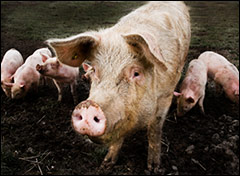In a stuffy room on Capitol Hill last week, I joined a couple dozen activists and farmers to discuss the farm bill. Why would we bother to meet in hot-as-an-oven Washington D.C. to discuss the legislative mess that recently sputtered to an all too drawn-out end?
While the ink is barely dry on the new farm legislation, the campaign for the 2012 Farm and Food Bill has already begun. The group of grassroots advocates met in D.C. last week to wipe the sweat from their brows, roll up their sleeves, and begin to strategize a coordinated effort to ensure $14 billion of funding won in the new farm bill translates into real support for sustainable farmers, environmental stewardship, rural economic development, urban food projects, and other good food efforts.
The $14 billion worth of programs can grow and nourish sustainable food and agriculture efforts around the country and in doing so, build the power of the 2012 Farm and Food Bill movement along the way. One of the keys is getting the word out about these new programs so that farmers and organizations can benefit from them.
Critics have likened the farm bill wins to “crumbs” because they represent a small part of the overall farm bill loaf. The relative merits of incremental change can be debated in another post, but for people serious about changing the food system, the programs in the new farm law that support everything from beginning farmers to organic production to conservation on working land represent real reforms that can benefit real people doing some really good things on the land and in their communities.
Maria Luz and her husband Florentino Collazo are an example of the kind of farmer success story that we could see blossom throughout the country if farmers and organizations take advantage some of the new farm bill wins.
Maria and Florentino currently grow organic produce, including melons and orchard crops, on their farm in Monterey County, California. Before becoming full-time farmers, Maria worked for fifteen years at an asparagus-packing facility, while Florentino harvested and packed lettuce in the fields of the Salinas Valley.
When Maria and Florentino decided to take steps toward realizing their dream of someday owning their own farm, they went to the Agriculture and Land-Based Training Association (ALBA), a community-based organization in Salinas. ALBA’s research shows that a farmworker in the Salinas Valley typically earns less than $20,000 a year. The opportunity for Maria and Florentino to earn a gross income of more than $10,000 per planted acre was significant, but like most new farmers, they needed access to technical skills and financial assistance.
Through ALBA’s farm incubator program, Maria and Florentino learned organic farming methods and honed their marketing skills. After several years of farming three acres rented from ALBA and putting away some savings, Maria and Florentino were able to purchase their own farm. The financing was made possible through an Individual Development Account organized by California FarmLink and a beginning farmer purchase loan through the Department of Agriculture’s Farm Service Agency. Along with their savings, these programs allowed Maria and Florentino to buy 10 acres and start their own farm.
Today, Maria grows and sells hot-season crops from her 10 acres as well as cool-season crops from three acres she continues to rent from ALBA. She and Florentino market their produce through ALBA Organics and at the farmers’ markets and farm stand at the Carmel Mission every Sunday morning.
Over the next five years, beginning farmers throughout the country will have the opportunity to benefit from the kinds of technical and financial assistance offered to Maria and Florentino. This is because there is more funding for beginning farmer and rancher programs in the new farm law than ever before, including a Beginning Farmer and Rancher Development Program, Individual Development Account Pilot Program, down payment loan program, and others. Not only may more farmers get a start on the land because of these wins, they can also make a connection to the grassroots movement fighting for long-term policy change. Ultimately, this is the best way to ensure that legislative support for good policy alternatives will continue to grow.
There are all sorts of ways that we as advocates for a healthier food system can be engaged in making the change we want to see, but some things can’t be left to the market. These include making sure that private agricultural land is managed sustainably, and guaranteeing there is adequate public funding for classical plant and animal breeding at land-grant universities, and bringing farmers markets to vulnerable rural towns and urban centers. These, in addition to the beginning farmer programs mentioned above are just a few examples of the kinds of good programs that survived the farm bill fight.
So what happens now that the farm bill is over? We take the “crumbs” that we won, invest in our land, farmers, and communities, and build an even stronger grassroots movement for 2012.


